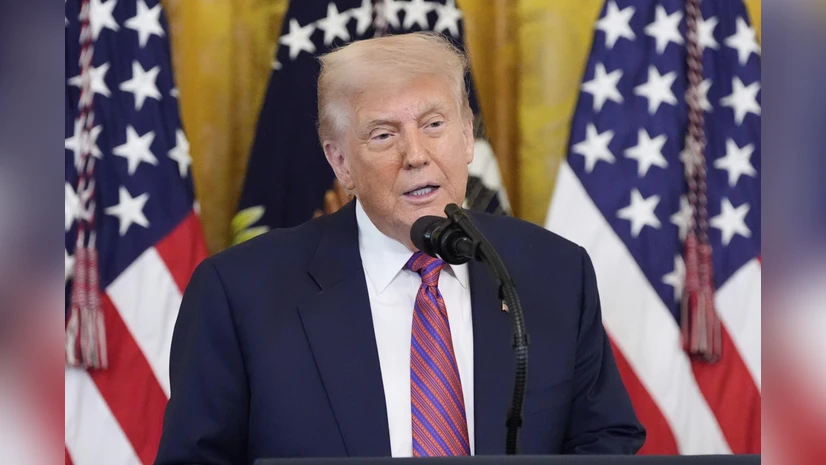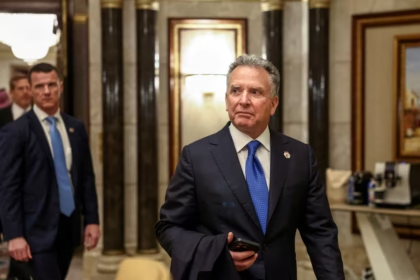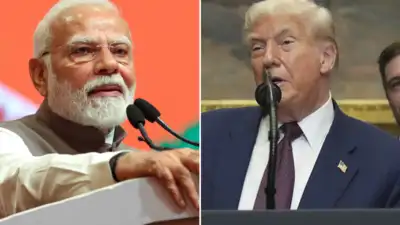Trump’s Economic Agenda, U.S. Elections, and the Politics of Trade
The Alaska summit between former U.S. President Donald Trump and Russian President Vladimir Putin has drawn worldwide attention not only because of its symbolic setting but also due to the far-reaching geopolitical and economic issues discussed. Among the most consequential outcomes was Trump’s statement that he “may hold off on imposing secondary tariffs on India” over its continued purchase of discounted Russian oil. This single announcement sent ripples through global markets, diplomatic circles, and policy think tanks, as it touched on three sensitive areas at once: U.S.-India relations, the Russia-Ukraine war economy, and Washington’s sanctions strategy.
For months, the U.S. establishment has debated how to handle India’s growing role as a top buyer of Russian crude oil. After Western sanctions disrupted Russia’s traditional markets in Europe, Moscow leaned heavily on Asia—particularly India and China—to absorb its exports. India, driven by economic pragmatism and its growing energy needs, took advantage of steep discounts offered by Russia. While the Biden administration had largely tolerated this under its “don’t break sanctions, but buy smartly” approach, Trump’s potential comeback into global leadership recalibrated the conversation. His words in Alaska have therefore become more than a passing remark—they have reshaped expectations for the trajectory of U.S.-India trade and diplomacy.
Why Alaska Mattered
The choice of Alaska as the venue was both symbolic and strategic. Situated between the U.S. mainland and Russia, the location underscored the delicate balance of proximity and rivalry between the two nuclear powers. The cold, stark backdrop mirrored the icy complexities of U.S.-Russia relations. Yet, Trump’s pivot during the summit to focus on India’s oil purchases from Russia demonstrated his characteristic ability to inject unpredictability into high-level talks.
Observers noted that Trump deliberately linked the issue of India’s trade with Russia to the broader framework of U.S.-Russia negotiations. This tactic was twofold: first, to pressure Moscow by highlighting its dependence on Asian markets, and second, to signal to New Delhi that Washington’s patience had limits—even under Trump’s more transactional leadership style.
The Indian Dilemma
India now finds itself in a delicate balancing act. On one hand, its partnership with Russia is long-standing, rooted in decades of defense cooperation and energy trade. On the other, its strategic relationship with the United States has become increasingly vital, especially in the context of countering China’s rise in the Indo-Pacific region.
Trump’s statement in Alaska, therefore, carries dual implications for India:
- Immediate Relief – By saying he “may hold off,” Trump has temporarily reduced pressure on India, allowing it to continue importing discounted oil without the immediate threat of U.S. secondary tariffs.
- Strategic Uncertainty – The phrase “may hold off” is intentionally vague, leaving New Delhi uncertain about how long this leeway will last and under what conditions Washington might reverse course.
This ambiguity is classic Trump—keeping allies and adversaries alike guessing, while retaining flexibility for future leverage.
Economic Ripples
Financial markets quickly reacted to Trump’s announcement. Oil traders speculated that India would step up its Russian crude imports in the short term, taking advantage of the breathing space before any potential tariffs materialize. Meanwhile, U.S. companies with business links to India welcomed the signal of restraint, as tariffs could have triggered retaliatory measures and strained the broader trade partnership.
Policy analysts also pointed out that Trump’s stance reflects a calculated economic strategy. By holding the tariff card close to his chest, he can use it as a bargaining chip—either with Russia, to reduce Moscow’s leverage, or with India, to extract concessions in unrelated areas such as defense contracts, tech investments, or agricultural exports.
India’s Oil Dependency and the Energy Security Puzzle
India’s position in the global energy matrix is unique and complicated. As the world’s third-largest importer of crude oil, India relies on foreign supplies for more than 85% of its domestic demand. This overwhelming dependence on imports leaves the country highly vulnerable to price fluctuations, supply chain disruptions, and geopolitical tensions. Against this backdrop, the availability of discounted Russian oil has been a lifeline for New Delhi’s economy.
When Western nations imposed sanctions on Moscow after its Ukraine invasion, many global players cut their reliance on Russian energy. India, however, viewed the situation differently. It saw an opportunity to secure cheap and stable energy supplies, especially when global crude prices soared beyond $100 per barrel in 2022–23. For a country where millions struggle with inflation, subsidized or discounted oil imports had direct domestic benefits—ranging from lower fuel inflation to better fiscal stability for the government.
The Scale of India’s Russian Oil Imports
By 2024, India had become one of the largest buyers of Russian crude, with imports crossing 1.6 million barrels per day at peak levels. This marked a dramatic shift in trade flows: Russia, once a marginal supplier to India, overtook traditional exporters like Iraq and Saudi Arabia. The economic savings were significant. Reports estimate that India saved billions of dollars on its oil bill due to these discounts.
But the arrangement also brought risks. India’s increasing reliance on Russian oil came under constant scrutiny from Western allies, especially the U.S. and the EU, who worried that India’s purchases were indirectly funding Moscow’s war chest.
Trump’s latest announcement from the Alaska summit—indicating that he “may hold off” on secondary tariffs—temporarily shields India from this criticism at a policy cost-benefit level. Still, the larger question remains: how sustainable is India’s current path?
Domestic Economic Priorities
For Prime Minister Narendra Modi’s government, ensuring energy affordability is non-negotiable. Rising oil prices quickly translate into higher fuel and transportation costs, which ripple into food inflation and public discontent. With elections always looming in a country as politically vibrant as India, no government can afford a prolonged spike in inflation driven by fuel costs.
Russian oil, therefore, provides more than just barrels of crude—it offers political breathing space. It allows New Delhi to keep pump prices stable, control inflation, and divert fiscal resources to other developmental projects.
Strategic Hedging: India’s Energy Diplomacy
What makes India’s case particularly complex is its multi-vector energy diplomacy. While it buys heavily from Russia, it has not abandoned its ties with the Middle East. In fact, New Delhi continues to deepen its energy ties with Saudi Arabia, the UAE, Iraq, and Qatar, ensuring that no single supplier dominates its portfolio.
This balancing act reflects India’s strategic approach:
- With Russia – Energy at a discount, plus long-standing defense ties.
- With the U.S. – Strategic partnership, tech investments, defense cooperation, Indo-Pacific strategy.
- With the Middle East – Reliable energy flows and opportunities for diaspora-driven remittances.
In this context, Trump’s Alaska statement becomes both a shield and a sword. While it shields India in the short term from punitive tariffs, it also leaves the sword of uncertainty hanging over its long-term energy strategy.
The Risk of Secondary Tariffs
Secondary tariffs are designed to punish third-party countries or companies that facilitate trade with sanctioned nations. For India, facing such tariffs from Washington would not only disrupt its oil imports but also have wider financial repercussions. Indian banks, shipping companies, and insurance firms involved in Russian oil deals could face restrictions in accessing the U.S. financial system.
This is why Trump’s words matter. His phrasing—“may hold off”—offers flexibility but not certainty. It gives India space, but it also makes clear that the U.S. can pull the tariff trigger anytime Washington feels New Delhi has crossed a political or economic red line.
The decision by former U.S. President Donald Trump to signal flexibility toward India’s Russian oil imports cannot be viewed in isolation. It is tied directly to his broader economic philosophy, his “America First” trade agenda, and the political calculus of U.S. elections. At its core, Trump’s policy approach has always blended foreign policy with domestic economic interests, often viewing international engagements through a transactional lens.
Trump’s “America First” Playbook
From his first term in office, Trump consistently framed U.S. global policy around the idea that every international deal must directly benefit American workers, companies, and taxpayers. Whether it was trade with China, NATO contributions, or energy policies, his question was simple: “What does America get in return?”
This mindset continues to shape his decisions today. By holding off on secondary tariffs against India, Trump is not offering a free pass. Instead, he is leaving the door open for bargains, concessions, or reciprocal benefits. In effect, India’s energy choices could become a negotiating chip for future U.S.-India trade talks, defense deals, or geopolitical alignments.
U.S. Elections and the Energy Narrative
Domestic politics in the U.S. also play a critical role. Trump, eyeing another term in office, must address concerns about:
- High energy prices in America.
- Domestic oil and gas production.
- Perceptions of U.S. weakness against Russia.
While U.S. voters are less concerned about India’s oil imports specifically, they do care about how Trump handles Russia and global trade fairness. By taking a softer stance on India now, Trump positions himself as pragmatic but firm, signaling to voters that he will not jeopardize America’s partnerships in Asia while still keeping Russia “in check” through other means.
In campaign speeches, this narrative becomes a powerful talking point: “We’re making smart deals. We’re protecting American jobs. We’re not letting other countries take advantage of us.” India, therefore, becomes part of a broader political theater, where foreign policy decisions feed into Trump’s domestic political messaging.
Trade as a Bargaining Chip
For Trump, tariffs are not just punitive measures—they are negotiation tools. In the past, he used tariffs against China not only to punish but also to extract better trade terms. The same logic applies here.
By hinting that tariffs against India are possible but not inevitable, Trump keeps leverage in his hands. This gives him the flexibility to demand:
- Greater defense procurement from U.S. companies (fighter jets, naval systems, drones).
- More market access for American goods and services in India.
- Closer alignment with U.S. geopolitical strategies, particularly in the Indo-Pacific against China.
In short, Trump views tariffs not as the endgame but as pressure points to achieve broader goals.
India in the U.S. Strategic Equation
Washington sees India as a critical partner in balancing China’s rise. This is why successive U.S. administrations—Republican and Democrat—have invested in strengthening ties with New Delhi. For Trump, this strategic logic remains intact, but he prefers transactional partnerships over long-term commitments.
India’s reliance on Russian oil creates both a problem and an opportunity for him. The problem is that it risks undermining U.S.-led sanctions against Moscow. The opportunity, however, is that it gives Trump leverage to negotiate harder with India on unrelated issues—from trade deficits to defense cooperation.
Trump’s Relationship with Putin: The Alaska Optics
The Alaska summit with Vladimir Putin carries symbolic weight. Trump’s critics often accuse him of being too soft on Russia. By signaling toughness on sanctions while giving India room, Trump attempts to balance domestic optics and foreign policy pragmatism.
He can present the Alaska summit as proof that he is “tough on Russia” while simultaneously telling allies like India: “I’ll protect you from tariffs, but I expect something in return.” This balancing act reflects his well-known negotiation style—keeping all sides slightly uncertain but always positioning himself as the ultimate dealmaker.
Uncertainty as a Strategy
Perhaps the most consistent feature of Trump’s policy style is strategic unpredictability. By refusing to clearly commit to a path—whether on tariffs, trade, or alliances—he ensures that all parties remain cautious and engaged with him directly.
For India, this means that today’s relief on secondary tariffs could easily turn into tomorrow’s pressure campaign if Trump feels it benefits his domestic political goals or strengthens his bargaining power internationally.
India stands at the crossroads of three overlapping geopolitical triangles—with Russia as its historic defense partner, the United States as its rising strategic ally, and China as its most pressing security challenge. Donald Trump’s signaling of possible leniency on secondary tariffs underscores how these dynamics intertwine and why India must tread carefully in navigating its external relationships.
India and Russia: A Historic Partnership Under Pressure
India’s ties with Russia are not recent—they stretch back to the Cold War era, when Moscow was New Delhi’s most reliable defense and diplomatic partner.
- Defense dependence: Even today, an estimated 60–70% of India’s military hardware is of Russian origin. From fighter jets to nuclear submarines, Russia remains a critical supplier.
- Energy security: With rising domestic energy demands, India has turned to discounted Russian crude oil since the Ukraine war, reinforcing the partnership at a time when the West seeks to isolate Moscow.
- Strategic trust: Russia has consistently supported India at global forums, particularly on issues like Kashmir.
But this historic reliance now sits uneasily with U.S.-led sanctions. Trump’s threat—and simultaneous hesitation—on tariffs highlights the fragile balancing act India must maintain.
India and the U.S.: A Strategic Partnership in Motion
Over the last two decades, India and the U.S. have built what is often called a “strategic convergence.”
- Defense cooperation: India has signed foundational defense agreements with Washington, opening doors to intelligence sharing and high-tech transfers.
- Trade and investment: The U.S. is now one of India’s largest trading partners, with growing cooperation in digital services, pharmaceuticals, and clean energy.
- Geopolitical alignment: Both nations are members of the Quad (with Japan and Australia), designed to counterbalance Chinese dominance in the Indo-Pacific.
Trump’s calculation here is pragmatic: he wants to keep India close, but on terms favorable to American industries and workers. By holding off on tariffs, he avoids antagonizing New Delhi while leaving the door open for further bargaining.
India and China: The Shadow of Rivalry
The third corner of India’s balancing act is China, which looms as both an economic competitor and a strategic adversary.
- Border disputes: Since the deadly Galwan Valley clash of 2020, India–China relations remain strained.
- Economic ties: Despite tensions, China is still one of India’s largest trading partners, creating a paradox of dependency and distrust.
- Geopolitical rivalry: Both nations compete for influence across South Asia, the Indian Ocean, and global institutions.
For India, U.S. partnership is crucial in countering Chinese assertiveness. Trump’s transactional approach may be unpredictable, but his tough stance on China aligns with New Delhi’s long-term interests.
New Delhi’s Strategy: Multi-Alignment, Not Non-Alignment
Unlike during the Cold War, when India espoused a “non-aligned” posture, today’s policymakers speak of “multi-alignment.”
This strategy involves engaging deeply with multiple powers without becoming overly dependent on any single one. For India, this means:
- Continuing defense procurement from Russia while diversifying supplies from the U.S., France, and Israel.
- Strengthening U.S. ties without abandoning energy deals with Moscow.
- Managing China pragmatically while seeking support from the U.S. and partners to counterbalance Beijing.
Trump’s tariff threat, therefore, is not merely an economic issue for India—it’s a test of its ability to balance complex partnerships without undermining its strategic autonomy.
Trump’s Unpredictability and Its Implications for India
For Indian policymakers, Trump’s style of governance is both an opportunity and a challenge.
- Opportunity: His willingness to cut deals could mean India can secure exemptions or concessions through direct negotiation.
- Challenge: His unpredictability creates uncertainty, making long-term planning difficult.
New Delhi must constantly prepare for sudden shifts in U.S. policy—from tariffs to sanctions—while leveraging its geopolitical importance to secure favorable outcomes.
Conclusion: India’s Tightrope Walk
India’s balancing act is a tightrope walk across three competing arenas: Russia for legacy defense and energy, the U.S. for technology and strategic alignment, and China as a direct competitor. Trump’s hinted flexibility on secondary tariffs does not resolve this challenge—it only reinforces it.
For New Delhi, the message is clear: in a world shaped by Trump’s transactional politics, India must play its cards with agility, patience, and strategic foresight. The coming months will test whether India can continue walking this tightrope without losing its balance.
Also Read : Elderly Mumbai Woman Loses ₹1.85 Lakh in Online Delivery App Milk Scam








